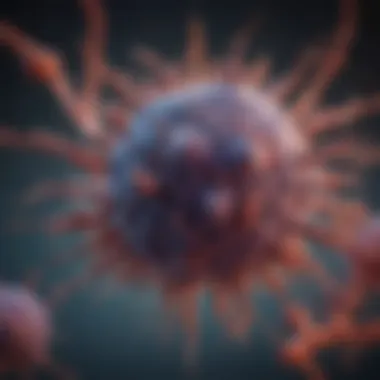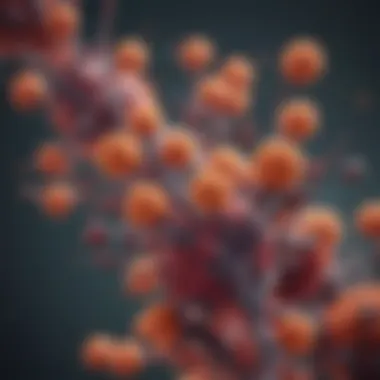Activated Ras Antibody: Insights in Molecular Biology


Intro
The study of activated Ras antibodies holds significant promise in the realm of molecular biology, particularly within cancer research. These antibodies play a crucial role in understanding the complexities surrounding Ras proteins, which are vital in cell signaling pathways. This article will dissect the core aspects of activated Ras antibodies, emphasizing their functioning mechanisms, their diagnostic and therapeutic potential, and their growing importance in contemporary biological science.
Key Findings
Summary of the main results
Research surrounding activated Ras antibodies has yielded several pivotal findings. Firstly, these antibodies have shown potential in distinguishing between different activation states of Ras proteins. This is crucial, as activated Ras proteins are implicated in various cancers. Beyond their diagnostic utility, activated Ras antibodies can also be leveraged in targeted therapies. Such therapies aim at inhibiting the aberrant signaling that characterizes numerous malignancies linked to Ras. Recent studies have demonstrated that specific antibodies can effectively block the action of mutated Ras, fostering an environment for improved treatment outcomes.
Significance of findings within the scientific community
The implications of these findings are profound. By providing enhanced specificity in cancer diagnostics, activated Ras antibodies help in tailoring treatments more effectively. This targeted approach may improve patient survival rates and minimize the adverse effects commonly associated with traditional therapies. Furthermore, these discoveries foster a deeper understanding of the initial triggers of oncogenesis. As a result, researchers are exploring further nuances in Ras signaling that could lead to even more advanced therapeutic options.
Implications of the Research
Applications of findings in real-world scenarios
The real-world applications of activated Ras antibody research are gradually manifesting. In clinical settings, these antibodies have the potential to guide diagnostic processes and facilitate personalized medicine. For instance, patients with specific Ras mutations could receive therapies designed to target those mutations based on the antibody profiles determined through testing.
Potential impact on future research directions
Future research could further harness the insights gained from activated Ras antibodies. Potential explorations might include combining these antibodies with other therapeutic agents to enhance efficacy. Additionally, research efforts could aim to explore the development of new antibodies that target Ras related pathways more effectively, paving new avenues for innovative cancer treatments.
"Activated Ras antibodies are not just a tool; they are key players in revolutionizing our approach to cancer diagnostics and therapies."
Overall, the exploration surrounding activated Ras antibodies reflects a growing field, eager to address ongoing challenges in cancer treatment and diagnosis patiently. As such, researchers, students, and educators should remain attuned to the developing narratives in this crucial area of molecular biology.
Foreword to Activated Ras Antibodies
The investigation into activated Ras antibodies is pivotal for understanding complex signaling pathways in cellular biology, particularly in the context of oncogenesis. Ras proteins are comprehensive regulators of cell growth and differentiation, serving as molecular switches that toggle between active and inactive states. The ability to study and manipulate these states using targeted antibodies enhances our comprehension of tumor biology, thereby guiding therapeutic interventions.
Targeting activated Ras proteins has gained prominence due to their frequent dysregulation in cancer. Many neoplasms exhibit constitutively active Ras mutations, which drive uncontrolled cell division. Hence, activated Ras antibodies present a powerful tool for research into cancer mechanisms, diagnosis, and prospective therapies. This section aims to illuminate the fundamental concepts behind Ras proteins and the significance of their activated states.
Understanding Ras Proteins
Ras proteins comprise a family of small GTPases, primarily including H-Ras, K-Ras, and N-Ras. They are encoded by the HRAS, KRAS, and NRAS genes, respectively. Each of these proteins plays a crucial role in transmitting signals from growth factor receptors to downstream effectors that promote cellular responses such as proliferation and survival. When bound to GTP, Ras is considered 'active', while being bound to GDP renders it 'inactive'.
The transition between these states is not spontaneous and requires the action of several regulatory proteins, including guanine nucleotide exchange factors and GTPase-activating proteins.
Various diseases, particularly cancer, are closely associated with mutations in these Ras genes. Mutations can lead to chronic activation of Ras proteins, contributing to oncogenic transformation.
Significance of Activation States
The state of Ras proteins—active or inactive—determines their interaction with various downstream pathways. The active state, characterized by GTP binding, prompts Ras to engage other signaling molecules, leading to the activation of pathways such as the MAPK/ERK and PI3K/AKT. These pathways are integral not only to normal cell function but also to pathological states like cancer.
In tumor biology, the distinction between active and inactive states has substantial implications. The presence of activated Ras can serve as a biomarker for certain cancers, guiding treatment and prognosis. In this sense, activated Ras antibodies can help visualize and quantify this activation status in clinical samples, thus enabling more precise diagnostics.


"Understanding the nuances of activated Ras proteins may reshape our approach to cancer treatments and diagnostics."
In summary, the exploration of activated Ras antibodies provides insights that extend beyond basic biology, informing clinical practices and therapeutic developments. Their significance lies in the ability to discern the active states of Ras proteins and the subsequent impact on cellular behavior, particularly in cancer contexts.
Biochemical Mechanisms of Ras Activation
The biochemical mechanisms that govern Ras activation are pivotal in understanding its role in molecular biology, especially in cancer research. Activated Ras proteins serve as molecular switches that influence a variety of signaling pathways. These pathways regulate cell growth, differentiation, and survival. Studying the mechanisms of Ras activation helps in delineating the complex interplay of molecular signals that contribute to tumor progression and the potential development of targeted therapies.
GTPase Cycle and Regulatory Factors
The GTPase cycle is foundational in the regulation of Ras function. Ras proteins exist in two states: an inactive GDP-bound form and an active GTP-bound form. The switching between these states occurs primarily through the hydrolysis of GTP to GDP, a reaction catalyzed by intrinsic GTPase activity.
Regulatory factors play a significant role in this cycle. These include:
- Guanine Exchange Factors (GEFs): These proteins facilitate the exchange of GDP for GTP, effectively activating Ras. They bring Ras into a more favorable conformation enabling GTP binding.
- GTPase-Activating Proteins (GAPs): These proteins accelerate GTP hydrolysis, returning Ras to its inactive form. They ensure that Ras signaling is tightly regulated.
- Ras Superfamily Proteins: These constitute a larger family of GTPases that share similar mechanisms but can have distinct cellular functions.
A thorough grasp of the GTPase cycle and its regulatory factors provides insight into potential therapeutic targets for diseases where Ras activation is dysregulated.
Role of Guanine Exchange Factors
Guanine Exchange Factors, or GEFs, are critical in the activation of Ras proteins. These proteins promote the binding of GTP, which activates Ras and initiates downstream signaling cascades.
Several key points illustrate the importance of GEFs:
- Activation Mechanism: GEFs induce a conformational change in Ras that allows for GDP release and GTP binding.
- Diversity of GEFs: There are multiple types of GEFs that target different Ras isoforms, leading to varied cellular outcomes.
- Pathological Implications: Aberrant GEF activity can lead to uncontrolled Ras signaling, contributing to oncogenesis.
Understanding how GEFs interact with Ras expands our knowledge of signaling dynamics and unveils avenues for therapeutic intervention.
Implications of Mutational Changes
Mutational changes in Ras genes are a significant area of focus in cancer research. Mutations frequently occur at codons 12, 13, and 61, leading to constitutive activation of Ras. These mutations hinder GTP hydrolysis, leaving Ras in its active state perpetually.
Some considerations include:
- Cancer Prevalence: Mutations in the KRAS gene are among the most common in various cancers, including pancreatic, colorectal, and lung cancer.
- Therapeutic Fog: The nature of these mutations complicates treatment options. Current therapies targeting Ras must be designed to overcome the persistent activation states.
- Biomarker Potential: Mutations can serve as biomarkers for specific types of cancer, guiding treatment decisions.
In summary, the insights gained from studying the biochemical mechanisms of Ras activation are essential for broadening the understanding of its role in cell signaling and disease. The knowledge gained here can lead to innovative strategies in cancer diagnostics and therapeutics.
Development of Activated Ras Antibodies
The development of activated Ras antibodies represents a crucial advancement in molecular biology, particularly in understanding the intricate mechanisms that drive oncogenesis. As Ras proteins play a pivotal role in cellular signaling pathways, the ability to generate specific antibodies that recognize their active forms holds significant implications for both research and therapeutic applications. This section delves into the methodologies involved in antibody generation and the importance of characterizing their specificity, which ultimately shapes their utility in cancer research.
Techniques for Antibody Generation
Generating activated Ras antibodies requires a blend of innovative approaches and technologies. Several techniques have emerged to produce high-quality antibodies that target the active forms of Ras proteins. Common methods include:
- Hybridoma Technology: This traditional approach involves fusing B lymphocytes with myeloma cells, enabling the production of monoclonal antibodies. By immunizing mice with activated Ras proteins, researchers can isolate specific hybridoma clones that secrete antibodies targeting the desired Ras epitope.
- Recombinant Antibody Technology: This method utilizes genetic engineering to create humanized or fully human antibodies. By employing phage display libraries or yeast display systems, researchers can meticulously select antibodies with high affinity for activated Ras proteins, advancing the scope of personalized medicine.
- Single Domain Antibodies: Also known as nanobodies, these minimalistic antibodies derived from camelids offer advantages in specificity and binding. Their unique structure enables them to recognize epitopes that conventional antibodies may miss, making them valuable tools in Ras research.


Choosing an appropriate technique depends on factors such as cost, scalability, and the specific requirements of the research question. Thus, a hybrid approach often provides the best results, ensuring robustness in both specificity and affinity targeting.
Characterization of Antibody Specificity
Once antibodies are generated, it is vital to characterize their specificity to ensure they accurately detect the activated forms of Ras proteins. This process involves several key steps:
- Epitope Mapping: Identifying the exact region of the Ras protein that the antibody interacts with is essential. Techniques like peptide arrays and mass spectrometry can assist in elucidating the binding sites, providing insights into how antibodies recognize their targets.
- Affinity Testing: Measuring the strength of the interaction between the antibody and its target is crucial. Surface plasmon resonance (SPR) and enzyme-linked immunosorbent assay (ELISA) are common methods used to quantify binding affinities.
- Cross-Reactivity Analysis: It is important to assess whether the antibody can bind to non-target proteins. This evaluation ensures that the specificity of the antibody is maintained under physiological conditions, thereby enhancing the reliability of subsequent applications in research or diagnostics.
- Functional Assays: Employing functional assays to evaluate the biological relevance of the antibody is essential. For activated Ras antibodies, assays that monitor downstream signaling pathways can provide evidence of their efficacy in modulating Ras activity.
Understanding the specificity of activated Ras antibodies is foundational for their application in both basic and clinical research. Such knowledge enables researchers to decipher the nuanced roles of Ras activation in cancer and other diseases.
The process of developing and characterizing activated Ras antibodies is not only vital for advancing the understanding of Ras biology but also lays the groundwork for potential therapeutic interventions. By honing in on specific biomarkers associated with oncogenic Ras mutations, researchers can foster targeted therapies that may improve patient outcomes.
Applications of Activated Ras Antibodies in Cancer Research
The study of activated Ras antibodies plays an important role in understanding cancer biology. These antibodies target specific mutants of Ras proteins, which are often implicated in various cancers. Activation of Ras leads to uncontrolled cell growth and proliferation. Therefore, strategically using these antibodies can help to inhibit oncogenic signaling pathways. This application is becoming central in both research and therapeutic contexts.
Targeting Oncogenic Ras Mutants
Oncogenic Ras mutants arise from mutations in genes that code for Ras proteins, most commonly KRAS, NRAS, and HRAS. These mutations can lead to a constitutively active state of the protein, perpetuating growth signals within the cell. Activated Ras antibodies can selectively bind to these abnormal forms, curtailing their activity.
- Targeting KRAS mutations is particularly paramount since it is prevalent in pancreatic, colorectal, and lung cancers.
- Research indicates that using activated Ras antibodies can promote apoptosis in cells harboring these mutants.
- Such targeted approaches can lead to more personalized therapy, aligning treatments with the specific genetic profiles of patients.
Furthermore, the design of these antibodies can vary. Some may be engineered to block Ras effector pathways, while others might facilitate immune-mediated destruction of cancerous cells. This method reduces the off-target effects often seen with traditional chemotherapies.
Therapeutic Modalities and Clinical Trials
Current therapeutic modalities utilizing activated Ras antibodies range from monoclonal antibodies to bispecific antibodies, designed for dual targeting. Investigational therapies are entering clinical trials, bringing optimism for effective treatments.
- Recent clinical trials have explored combining activated Ras antibodies with immune checkpoint inhibitors, enhancing overall efficacy.
- Some ongoing studies focus on incorporating these antibodies with existing chemotherapy regimens to increase treatment success rates.
- The flexibility of these antibodies allows researchers to adjust treatment strategies based on patient response.
Moreover, the importance of robust clinical data cannot be overstated. In many trials, measuring the response rates among patients with various Ras mutations provides critical insights into the efficacy and potential for wider application of these therapies.
Potential Side Effects and Efficacy Challenges
While there is significant promise in the application of activated Ras antibodies, potential side effects and challenges in efficacy must not be overlooked.
- Side Effects: Like any targeted therapy, adverse effects may arise. These include allergic reactions, infusion-related reactions, and immune system alterations.
- Resistance: Tumor cells might develop resistance mechanisms, undermining the effectiveness of antibodies over time. This poses a challenge for long-term treatment strategies.
- Specificity: Although designed to target oncogenic forms, there is a risk of cross-reactivity with wild-type Ras proteins, leading to unintended side effects.
The pathway towards harnessing activated Ras antibodies in cancer treatment is filled with intricacies. Continuous evaluation and adjustment of strategies based on emerging data will be vital in maximizing their therapeutic potential. Understanding both the promise and the pitfalls will ultimately advance cancer research and enhance treatment paradigms.
Diagnostic Potential of Activated Ras Antibodies
Activated Ras antibodies hold significant potential in the diagnostic landscape of various cancers. Their importance stems from the ability to detect specific Ras activation states, which can serve as biomarkers for tumor presence and progression. As cancer research advances, need for precise diagnostic tools becomes increasingly critical. This section examines how activated Ras antibodies can contribute to diagnostics, highlighting key elements and considerations in their application.
Biomarkers in Cancer Diagnostics
In cancer diagnostics, biomarkers are substances that indicate the presence or severity of disease. Activated Ras proteins, particularly those in their GTP-bound state, are prevalent in many malignancies. Detection of these active forms can aid in identifying oncogenic transformation in cells.


Some key advantages of utilizing activated Ras antibodies as biomarkers include:
- Specificity: They target distinct Ras activation states, enabling differentiation between normal and oncogenic signaling.
- Sensitivity: These antibodies can detect even low levels of activated Ras proteins, enhancing early detection of tumors.
- Prognostic Value: The presence of activated Ras may correlate with disease progression and patient outcomes, providing crucial information for treatment decisions.
However, challenges exist. These include the need for robust validation across diverse cancer types and patient populations. Furthermore, variability can arise in Ras expression levels due to external factors, necessitating careful interpretation.
Immunoassays and Detection Techniques
To leverage the potential of activated Ras antibodies in diagnostics, effective detection techniques are essential. Immunoassays are widely recognized for their ability to quantify proteins, including activated Ras. Common methods include:
- Enzyme-linked Immunosorbent Assay (ELISA): Utilizes activated Ras antibodies to quantify the presence of target proteins through enzymatic reactions, offering high sensitivity.
- Western Blotting: Involves separation of proteins by gel electrophoresis, followed by transfer and probing with specific activated Ras antibodies. This method allows for detection of not only the presence but also molecular weight of the target.
- Immunohistochemistry (IHC): A technique used in tissue samples. Activated Ras antibodies are applied to tissue sections to visualize protein expression, aiding in the histopathological assessment of malignancies.
Important Note: As techniques evolve, integration of activated Ras antibodies in multimodal diagnostic approaches is likely to enhance specificity and overall efficacy.
Future Directions in Ras Antibody Research
The landscape of Ras antibody research is continuously evolving, with significant implications for molecular biology. As researchers uncover complexities in the Ras signaling pathway, the focus shifts toward innovative solutions in antibody development and therapeutic integration. The future of this field appears promising, opening avenues for targeted therapies that address the persistent challenge of oncogenic Ras mutations.
Innovative Antibody Design Strategies
Designing antibodies with enhanced specificity and efficacy is a primary objective in biological research. Current strategies leverage both computational design and advanced biotechnological methods. High-throughput screening techniques enable researchers to identify and optimize antibody candidates more efficiently.
- Phage Display Technology: This involves using bacteriophages to display a library of antibodies, facilitating the selection of those with the highest binding affinities for activated Ras proteins.
- Recombinant DNA Technology: Utilizing recombinant techniques allows researchers to construct fusion proteins that can exhibit desired specificity, stability, and activity.
- Monoclonal Antibodies: The production and engineering of monoclonal antibodies represent a significant advancement. New analytics are crucial to ensure their effectiveness in targeting Ras mutations.
These strategies hold promise not only in improving existing antibody therapeutics but also in creating new ones that can tackle diverse Ras-related cancers. The enhanced understanding of antigen-antibody interactions further aids in tailoring antibodies to disease-specific pathways.
Integration with Other Therapeutic Approaches
The integration of activated Ras antibodies with other therapeutic modalities represents a significant area of exploration. Combining these antibodies with contemporary treatment strategies can amplify their effectiveness and broaden their application.
- Combination Therapies: Using activated Ras antibodies in conjunction with existing treatments such as chemotherapy or immunotherapy may improve treatment outcomes. For instance, pairing them with immune checkpoint inhibitors could enhance immune response against tumors harboring Ras mutations.
- Targeted Drug Delivery: By attaching activated Ras antibodies to therapeutic agents, the precision of drug delivery can increase, reducing side effects while maximizing drug efficacy. Delivery systems can be engineered to ensure the drug reaches only the cancer cells expressing activated Ras.
- Personalized Medicine: As genomic profiling becomes more prevalent, the ability to match patients with specific Ras mutations to corresponding antibody therapies can lead to more successful outcomes. This approach focuses on tailoring treatment to individual patient profiles, enhancing overall efficacy.
Future directions in Ras antibody research highlight the importance of interdisciplinary approaches and innovation, which can significantly impact the landscape of cancer therapy.
In summary, the future of activated Ras antibody research is bright, driven by innovative design strategies and synergistic therapeutic approaches. As this field advances, it promises to deliver powerful tools in the battle against cancer, fostering hopes for improved patient outcomes and a deeper understanding of molecular biology.
The End and Implications
The discussion surrounding activated Ras antibodies reveals significant aspects of their role within molecular biology, notably concerning cancer research and therapy development. Understanding how these antibodies function opens pathways to targeted treatment options, potentially revolutionizing patient care.
Summary of Findings
In summary, activated Ras antibodies provide considerable insight into the dynamics of Ras activation and its implications for oncogenesis. Key points include:
- Activation Mechanisms: The complexity of Ras activation through GTPase cycling involves various regulatory proteins.
- Antibody Production: Several advanced techniques have been utilized to generate highly specific antibodies that can recognize activated Ras.
- Applications in Cancer Research: Targeting Ras mutations through these antibodies has shown promise in preclinical and clinical settings, with potential therapeutic uses being explored.
- Diagnostic Potential: Activated Ras antibodies can serve as biomarkers, enhancing early detection of cancers associated with Ras activation states.
These findings highlight how critical activated Ras antibodies are in the context of advancing therapeutic options and diagnostic tools within oncology.
Broader Impact on Molecular Biology Research
The implications of activated Ras antibody research extend far beyond cancer treatment. Their applications impact various facets of molecular biology:
- Enhancing Knowledge of Signal Transduction: These antibodies serve as tools for studying the Ras signaling pathway, elucidating how cellular communication is altered in disease states.
- Revolutionizing Targeted Therapies: Their specificity may contribute to the refinement of targeted cancer therapies, minimizing off-target effects and improving patient outcomes.
- Informing Drug Development: Insights gained from this research may guide the design of new compounds aimed at inhibiting Ras activation, addressing a significant challenge in treating Ras-driven cancers.
The ongoing exploration of activated Ras antibodies signifies a vital progression in understanding molecular mechanisms and developing innovative treatment strategies.







